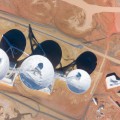With the advancement of human knowledge and technology, the idea of space exploration has become an achievable reality. As a result, scientists and engineers have designed and built spacecraft capable of traveling in outer space, exploring new planets, and conducting research beyond the boundaries of Earth. In this article, we will examine some of the key characteristics and technologies involved in a spacecraft.
The purpose of a spacecraft is to transport humans or equipment to and from the outer space environment. The ideal spacecraft should be able to sustain life and operate under extreme conditions such as exposure to radiation and lack of gravity. In order to achieve this objective, spacecraft are equipped with a multitude of instruments and technologies.

The structure of the spacecraft is one of the essential parts that needs careful design. A spacecraft's structure should be able to withstand the rigors of launch, maneuvering, and re-entry. The materials used in the construction of the spacecraft must also have the ability to operate at extreme temperatures, withstand radiation and cosmic rays, and be durable enough to withstand the harsh conditions of space.
One of the most important components of the spacecraft is the propulsion system. This system enables the spacecraft to reach orbit and travel to other planets. A spacecraft propulsion system can be classified into two types: chemical propulsion and electric propulsion.
Chemical propulsion systems utilize chemical reactions to provide the necessary thrust to propel the spacecraft. They are reliable and have a high thrust-to-weight ratio. Some examples of chemical propulsion systems are solid and liquid rocket motors.
Electric propulsion systems are more efficient and have a lower thrust-to-weight ratio, but these systems are less powerful and take more time to accelerate. These systems convert electrical energy into thrust using various methods such as ion propulsion and plasma thrusters.
The life support system is another critical component of a spacecraft. In order for humans to survive in space, the spacecraft must provide a stable environment that includes proper levels of oxygen, food, water, and waste management. The life support system includes air filtration and conditioning, water and waste recycling, and food storage and preparation.
The communication system is another essential component of the spacecraft. It enables the spacecraft to communicate with Earth and other spacecraft. The communication system consists of transmitters, receivers, and antennas. The communication system is crucial for mission control to track the spacecraft and to relay commands and data.
In summary, a spacecraft is a highly complex and sophisticated machine designed to transport humans and equipment to and from space. A spacecraft has multiple systems that work together to provide a successful mission. These systems include the propulsion system, the life support system, the communication system, and the structure of the spacecraft. With continued advancement in technology, we can expect to see even more advanced spacecraft in the future.













评论